#Gspell
Text

Suggested Reading
*- Highly suggested for beginners
What is Witchcraft?*
Fundamentals of Energy Work*
Spell Design*
Basics of Warding*
Basics of Binding
Basics of Banishing
Introduction to Gnosis*
Spell Dictation
Anchors
Paths of Least Resistance*
Conceptualization Vs. Visualization*
Research Tips*
Threshold Theory
Introduction
When first stepping onto the long winding path of witchcraft and mystical understanding it can be very intimidating, especially when it comes to casting your first few spells. The catch is that designing and casting spells is the only way to advance forward in your practice. It's a case of knowledge Vs. experience. Sadly, there isn’t much in the way of educational media on the topic of spell design, magic theory, and casting processes. This causes most practitioners to turn to Wiccan or Ceremonial sources for their initial research, neither of which are viable foundations for a well-rounded, effective and efficient craft.
Trinity of Spellcasting
Intent, Headspace/Focus, Passion are the cornerstones of spellcasting. These elements create the network or threshold in which spells pass through to their target. These concepts are also the root of what constitutes a spell. Intent is the designation of the target for the spell. Headspace is the sight in which the spell is aimed. Passion is the fuel that fires the spell towards the target. Without pure intent, the spell will apply broadly, lowering its potency and lead to potential unwanted side effects. Without a honed headspace, the spell will flicker out or lead to unpredictable results. A lack of Passion will cause a spell to be weak, ineffective, or latent.
Spellcasting Process
Before casting a spell, there are some preparations to be made, especially when first starting out.
Decide on what spellcasting method you’d like to use.
Find and gather any representations, correspondences, and environmental boons for your spell. (Enviromental boons being things like candles, music, incense, or a physically clean space.) If you are using incantations, be sure to memorize them to the best of your ability.
Set aside time and energy for casting. Try to ensure that you will not be interrupted.
Cleanse all tools and components that are going to be used.
Enter into a state of gnosis or trance.
Prepare your subtle body and energetically prepare all tools and representations.
Take your actions for casting, being sure to consciously do energy work as you do.
Calm or center yourself and do a physical movement that helps take you out of the headspace. (Ex. snapping, clapping, jumping, ringing a bell, etc)
Cleanse yourself, tools, representations, and the space.
Beginner Friendly Spellcasting Methods
Here are some methods for casting. They can be used in any combination, if desired. I often use all three in my spells.
Sympathetic Casting: Method of casting through items, herbs, crystals, taglocks, etc that are representative of your target, headspace, passion, and correspondences. These items create a mental network of concepts in order to cast.
Energetic Casting: Utilizing energy work to build constructs that contain all necessary components for a spell and then delivering it to the target.
Gestures: Using gestures to program the naturally existing energy into the components for a spell before delivering it to the target.
Intent, Desire, & Goals
Intent and desire are very different concepts. Intent is an inner truth, while desire is something that is wanted. Goals are an expectation of an outcome. For example, I am vehemently against capitalism and the notion of another’s loss for my benefit. Because of this inner truth, I struggle immensely with casting money magic, no matter how strong my desire is. No matter how clear my goal is.
Headspace, Aesthetics, & Visualization
Witchcraft and spellwork cannot be reliant on visualization and aesthetics. They are useful tools for constructing a strong headspace; but, using them alone will result in a spell not working, being ineffective, unpredictable, and/or weak. Using aesthetics to build yourself up will result in your spells working much better. Visualization isn’t energy work, but a tool to aid in planning and casting a spell, much like a wand. Aesthetics are an environmental boon. It helps build confidence, and assurance.
Focus, Trance, & Gnosis
Focus is the purpose of the headspace. The combination of the two is called a state of gnosis. When spellcasting, trances and states of gnosis can be extremely useful practices. Trances may be induced with *substances, music, self-hypnosis, etc. Trance makes it easier to be of one mind about the spell you’re casting. Gnosis is a meditation-like state in which one embodies the very concepts that make up a spell. In a state of gnosis you become the working, allowing the mind to become of a singular essence.
*-I am not suggesting using substances, nor condoning it. Merely stating that it is possible and is used by some practitioners.
Passion, Channeling, & Mental Health
When casting, it is in good practice and easy to get swept up in whatever emotions are involved in your spell. Emotions are channeled from the caster into the essence of the spell, empowering it. Depending on the working, this can be unhealthy or even dangerous if not done within reason and self-awareness. Channeling certain emotions can lead to triggering trauma responses or even cause trauma. Remain mindful of yourself and what emotions, memories, and/or actions may lead to worsening or feeding into mental-illness.
The Importance of Keeping a Spell Log, Critical Thinking & Objectivity
Especially when taking your first steps, keeping a log of your workings will allow you to remain objective and aware of your past casting. If a spell backfires, or has unwanted results, having a detailed log of your workings can make the canceling process much easier. Keeping a log will also aid in studying your craft as objectively as possible. Recording an estimation of when the spell should take effect, the specific goal, and qualifications of success will allow you to judge whether a spell was successful or not. When a spell isn’t successful it becomes a learning opportunity. Figuring out which components worked, what processes could be improved, etc. will help advance your craft rapidly if you cast regularly. When doing these studies, you are conceptualizing aspects of magical theory, or a critical approach to magic.
To read more about me, my content, my services, or to support me on Patreon click here!
#beginner witch#witchcraft101#spellwork#spellcraft#baby witch tips#baby witch#witchcraft basics#witchcraftguide#informational post#Gspell
845 notes
·
View notes
Text
Actualizar openSUSE 15.2 a openSUSE 15.3

Actualizar openSUSE 15.2 a openSUSE 15.3 de manera sencilla.
No vamos a hablar de las bondades de esta magnífica distribución Linux, pues muchos ya sabéis que es una de mis favoritas. OpenSUSE es una distribución diferente, potente, poderosa, fácil de usar, versátil y, con un funcionamiento como servidor empresarial que pocos le hacen sombra.
La forma de operar de openSUSE no hace que su actualización, sea tan simple como en otras distribuciones linux, sobre todos las basadas en deb, como Ubuntu, Linux Mint, etc. Consciente de que existen muchas dudas y errores al respecto, hemos realizado una instalación limpia de openSUSE 15.2 con Ext4 y, la hemos actualizado a openSUSE 15.3 con un resultado satisfactorio. En este artículo verás como lo hemos hecho, de forma rápida y sencilla.

Actualizar openSUSE 15.2 a openSUSE 15.3 de forma sencilla
Actualizar openSUSE 15.2 a openSUSE 15.3
Antes de comenzar, verificamos que efectivamente tenemos instalada la versión 15.2.
cat /etc/*release
Ejemplo...
localhost:~ # cat /etc/*release
NAME="openSUSE Leap"
VERSION="15.2"
ID="opensuse-leap"
ID_LIKE="suse opensuse"
VERSION_ID="15.2"
PRETTY_NAME="openSUSE Leap 15.2"
ANSI_COLOR="0;32"
CPE_NAME="cpe:/o:opensuse:leap:15.2"
BUG_REPORT_URL="https://bugs.opensuse.org"
HOME_URL="https://www.opensuse.org/"
localhost:~ #
Lo primero y muy importante, es deshabilitar los repositorios que no sean oficiales. Para ello desde YaST, accedemos a YaST Software Repositories.

Acceder a YaST Software Repositories
Una vez en YaST Software Repositories, deshabilita los repositorios que no sean oficiales. Deja habilitados, solo los que ves en la siguiente imagen.

Repositorios habilitados de openSUSE
Bien, una vez deshabilitados los repositorios no oficiales salimos de YaST. Abre la terminal y accede como superusuario.
sudo su
Ahora refrescamos los repositorios habilitados y actualizamos.
zypper ref
zypper up
Verás un resultado similar al siguiente.
localhost:~ # zypper ref
Repository 'Repositorio Non-OSS' is up to date.
Repository 'Repositorio principal' is up to date.
Retrieving repository 'Repositorio principal de actualizaciones' metadata
Building repository 'Repositorio principal de actualizaciones' cache .....
Repository 'Repositorio de actualizaciones (No OpenSource)' is up to date.
All repositories have been refreshed.
localhost:~ # zypper up
Building repository 'Repositorio Non-OSS' cache ........................
Building repository 'Repositorio principal' cache ......................
Building repository 'Repositorio principal de actualizaciones' cache ...
Building repository 'Repositorio de actualizaciones (No OpenSource)' cac
Loading repository data...
Reading installed packages...
Nothing to do.
Bueno, llego la hora de la verdad. Debes copiar la siguiente secuencia de comandos al completo y, pegarla en tu terminal. Lo que hacemos es modificar la versión 15.2 por la 15.3. Recuerda... copia todo completo y pégalo, si lo haces línea por línea no funcionara correctamente.
files="$(zypper lr -u | awk -F'|' '$4 ~ /Yes/ { gsub (" ", "", $2); r="/etc/zypp/repos.d/"$3".repo"; print r }')"
for f in $files
do
echo "Backup of $f saved to /root/ before patching it up ..."
cp -f "$f" /root/
sed -i 's+/leap/15.2+/leap/$releasever+' "$f"
sed -i 's+15.2.1+15.3+' "$f"
sed -i 's+15.2+15.3+' "$f"
done
Debe quedar como la siguiente imagen.

Migrar openSUSE 15.2 a openSUSE 15.3
Refrescamos los repositorios, indicando que sean los de la nueva versión 15.3.
zypper --releasever=15.3 ref
Ejemplo...
zypper --releasever=15.3 ref
localhost:~ # zypper --releasever=15.3 ref
Warning: Enforced setting: $releasever=15.3
Retrieving repository 'Repositorio Non-OSS' metadata .....................
Building repository 'Repositorio Non-OSS' cache ..........................
Retrieving repository 'Repositorio principal' metadata ...................
Building repository 'Repositorio principal' cache ........................
Retrieving repository 'Repositorio principal de actualizaciones' metadata
Building repository 'Repositorio principal de actualizaciones' cache .....
Retrieving repository 'Repositorio de actualizaciones (No OpenSource)' met
Building repository 'Repositorio de actualizaciones (No OpenSource)' cache
All repositories have been refreshed.
localhost:~ #
Llagó el momento de la actualización real. Te recomiendo ser paciente, puede demorar hasta 45 minutos.
zypper --releasever=15.3 dup
Ejemplo...
localhost:~ # zypper --releasever=15.3 dup
Warning: Enforced setting: $releasever=15.3
Retrieving repository 'Repositorio Non-OSS' metadata .....................
Building repository 'Repositorio Non-OSS' cache ..........................
Retrieving repository 'Repositorio principal' metadata ...................
Building repository 'Repositorio principal' cache ............................................
Retrieving repository 'Repositorio principal de actualizaciones' metadata ....................
Building repository 'Repositorio principal de actualizaciones' cache .........................
Retrieving repository 'Repositorio de actualizaciones (No OpenSource)' metadata ..............
Building repository 'Repositorio de actualizaciones (No OpenSource)' cache ...................
Loading repository data...
Reading installed packages...
Warning: You are about to do a distribution upgrade with all enabled repositories. Make sure these repositories are compatible before you continue. See 'man zypper' for more information about this command.
Computing distribution upgrade...
The following 156 NEW packages are going to be installed:
alsa-plugins-speexrate alsa-plugins-upmix alsa-ucm-conf coreutils-doc cryptsetup-lang dirmngr
evince evince-lang evince-plugin-pdfdocument file-roller file-roller-lang glibc-lang
gnome-calculator gnome-calculator-lang gnome-desktop-lang google-poppins-fonts gspell-lang
gtksourceview4-lang issue-generator kernel-default-5.3.18-57.3 kernel-default-extra
kernel-default-optional kernel-firmware-all kernel-firmware-amdgpu kernel-firmware-ath10k
kernel-firmware-ath11k kernel-firmware-atheros kernel-firmware-bluetooth kernel-firmware-bnx2
kernel-firmware-brcm kernel-firmware-chelsio kernel-firmware-dpaa2 kernel-firmware-i915
kernel-firmware-intel kernel-firmware-iwlwifi kernel-firmware-liquidio kernel-firmware-marvell
kernel-firmware-media kernel-firmware-mediatek kernel-firmware-mellanox kernel-firmware-mwifiex
kernel-firmware-network kernel-firmware-nfp kernel-firmware-nvidia kernel-firmware-platform
kernel-firmware-prestera kernel-firmware-qlogic kernel-firmware-radeon kernel-firmware-realtek
kernel-firmware-serial kernel-firmware-sound kernel-firmware-ti kernel-firmware-ueagle
kernel-firmware-usb-network kmod-bash-completion libLLVM11 libatopology2 libavcodec58_134
libavformat58_76 libavutil56_70 libblogger2 libbrotlienc1 libcbor0 libcdio19 libcrypt1 libdav1d5
libebtc0 libevdocument3-4 libevview3-3 libfido2-1 libfido2-udev libgepub-0_6-0
libgnome-desktop-3-18 libgnome-desktop-3_0-common libgspell-1-2 libgtksourceview-4-0
libgtop-2_0-11 libgtop-lang libldac2 libmfx1 libmpath0 libndr1 libnftables1 libnss_usrfiles2
libpeas-loader-python libply-boot-client5 libply-splash-core5 libply-splash-graphics5 libply5
libre2-9 libswresample3_9 libtextstyle0 liburing1 libyui-ncurses-pkg15 libyui-ncurses15
libyui-qt-graph15 libyui-qt-pkg15 libyui-qt15 libyui15 login_defs man-pages-es metamail mokutil
mpt-status nftables openSUSE-signkey-cert openssh-clients openssh-common openssh-server p7zip-full
pam-doc pam_pwquality patterns-base-documentation patterns-base-sw_management
patterns-yast-yast2_desktop perl-TermReadLine-Gnu perl-core-DB_File pipewire-lang postfix-ldap
procinfo procmail python3-brotlipy python3-cairo python3-nftables python3-smbc rpm-config-SUSE
ruby2.5-rubygem-mini_portile2 ruby2.5-rubygem-nokogiri setserial sharutils sharutils-lang spax
star star-rmt sudo-plugin-python system-group-audit system-group-kvm systemd-default-settings
systemd-default-settings-branding-openSUSE systemd-doc systemd-lang typelib-1_0-Libxfce4ui-2_0
typelib-1_0-Libxfce4util-1_0 typelib-1_0-Xfconf-0
virtualbox-kmp-default-6.1.22_k5.3.18_59.5-lp153.2.3.2 vlan xreader-plugin-comicsdocument
xreader-plugin-djvudocument xreader-plugin-dvidocument xreader-plugin-epubdocument
xreader-plugin-pdfdocument xreader-plugin-pixbufdocument xreader-plugin-psdocument
xreader-plugin-tiffdocument xreader-plugin-xpsdocument yast2-trans-en
The following 3 NEW patterns are going to be installed:
documentation sw_management yast2_desktop
The following NEW product is going to be installed:
"openSUSE Leap 15.3"
The following 22 packages are going to be REMOVED:
exo-branding-openSUSE exo-helpers hardlink kernel-firmware kmod-compat libexo-1-0 libndr0 libre2-6
libxfce4panel-1_0-4 libxfce4ui-1-0 libyui-ncurses-pkg11 libyui-qt-pkg11 patterns-base-apparmor_opt
patterns-base-enhanced_base_opt patterns-base-x11_opt python3-pycairo python3-pysmbc
systemd-bash-completion typelib-1_0-libxfce4util-1_0 xfce4-statusnotifier-plugin
xfce4-statusnotifier-plugin-lang xreader-backends
--------------etc............
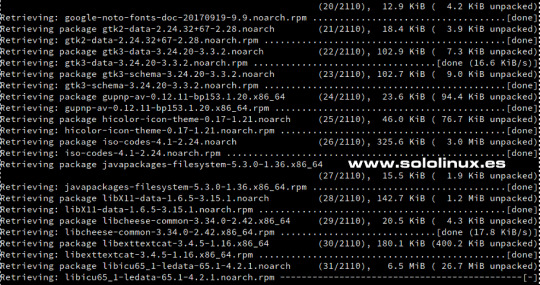
Descargar y actualizar los nuevos paquetes
Al concluir todo el proceso, te pregunta si quieres reiniciar el sistema. Responde "Y".
1762 packages to upgrade, 192 to downgrade, 156 new, 22 to remove, 1667 to change vendor.
Overall download size: 1.59 GiB. Already cached: 0 B. After the operation, additional 308.9 MiB will
be used.
Note: System reboot required.
Continue? (y):
Sorpresa!!!, al iniciar el sistema ya vemos que arranca openSUSE 15.3.
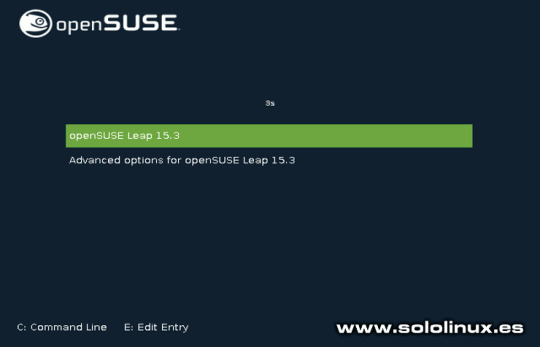
Iniciar openSUSE 15.3
Verificamos desde nuestra consola / terminal.
cat /etc/*release
El resultado es un exito.
localhost:~ # cat /etc/*release
NAME="openSUSE Leap"
VERSION="15.3"
ID="opensuse-leap"
ID_LIKE="suse opensuse"
VERSION_ID="15.3"
PRETTY_NAME="openSUSE Leap 15.3"
ANSI_COLOR="0;32"
CPE_NAME="cpe:/o:opensuse:leap:15.3"
BUG_REPORT_URL="https://bugs.opensuse.org"
HOME_URL="https://www.opensuse.org/"
localhost:~ #
Ahora solo te falta modificar los repositorios no oficiales en YaST Software Repositories (aunque se hayan modificado automáticamente, debes verificarlos de forma manual). Una vez termines el proceso, los habilitas y actualizas de nuevo para concluir todo el proceso.
sudo zypper ref
sudo zypper up
Canales de Telegram: Canal SoloLinux – Canal SoloWordpress
Espero que este artículo te sea de utilidad, puedes ayudarnos a mantener el servidor con una donación (paypal), o también colaborar con el simple gesto de compartir nuestros artículos en tu sitio web, blog, foro o redes sociales.
Chat de SoloLinux en Telegram
Read the full article
#deb#distribucionlinux#IniciaropenSUSE15.3#opensuse#openSUSE15.2#openSUSE15.2aopenSUSE15.3#openSUSE15.2conExt4#openSUSE15.3#servidorempresarial#YaST#YaSTSoftwareRepositories
1 note
·
View note
Conversation
me: is not catholic
my school: hey so the musical is godspell
me: cool *signs up as crew*
me: is still not catholic
me: spends all of rehearsals dancing to we beseech thee
me: ¯\_(ツ)_/¯
#but like actually it's such a jam#I fucking love it#COME SING ABOUT LOOOOOOOOOOOVVVEE#shush gracie#gspell
1 note
·
View note
Text
How do I know whether there is a spell on her husband
How do I know whether there is a spell on her husband
Sometimes when suddenly in a strong and happy family, where spouses live in peace and harmony, happens to be split and the man suddenly becomes totally indifferent to even the newly beloved wife or nay-begins to show its half unwarranted aggression. Of course, the reasons for such behavior may be quite different, but often, especially in cases where the husband when this woman appears on the side…
View On WordPress
0 notes
Text

Designing Spells, a how-to guide for every level of experience and discretion: Threshold Theory
Suggested Reading
*-Highly recommended
Threshold Theory*
Path of Least Resistance*
Anchors*
What is Witchcraft?*
Basic Energy Work
Conceptualization Vs. Visualization
Spell Dictation*
Spellcasting Basics*
Basic spell components:
All spells have a few components that are absolutely necessary for potent results. It is going to be assumed that physical and/or energetic work was done to actually prepare and cast the spell.
In order to cast a spell, one needs to be in a space of mind that facilitates the spell working. We often refer to this as ‘Headspace”, this assists one to be more focused. This can be the most difficult aspect of spellworking for some practitioners. The mind needs to be honed in on the spell, the energies, spirits, and intentions involved. This headspace exists to channel the practitioner's focus on the task at hand. This combination of headspace and focus is referred to as a state of gnosis.
Secondly, one would need to have passion, an emotional state that is used to fuel the spell.
Lastly, one needs to have an Intention for a spell. This is the most discussed aspect of spell casting, but is also the most misunderstood. Intention is not to be confused with desire. Intent is a personal truth, something that cannot be lied to. It is possible to cast a spell without one of these three components, however the spell most likely will not be as potent as if one did. You totally can cast spells based on desire and not intent, but validating the spell may be difficult or it may have varied results.
Too read about how to record your spells accurately, check out this post.
Correspondences, Tools, & External resources:
When looking through the internet or other informational resources and/or guides on witchcraft, you’ll probably notice that a few things tend to be regularly occurring:
1. That though a lot of practitioners may say that tools and correspondences aren’t necessary, a vast majority of sources and guides include and/or require correspondences and/or physical tools.
2. The correspondences used in each source are only as common as the dominant source for those correspondences within that specific tradition. For some, those sources are books, and for others they are the first result on a Google search.
When it comes to Tools used to perform magic, there are a few things that must be kept in mind. Some tools are culture/tradition specific and it would be disrespectful for you to use them, which may or may not have spiritual consequences. Many tools are used to accomplish the same ends. For example, wands and athames are used for very similar purposes, the casting and/or projection of energies within a specific space- typically when sanctifying an object or opening/closing a space for a working. If you decide to use a tool for your practice, please be sure that you understand the cultural ramifications of doing so within a spiritual space.
When it comes to Correspondences, there are a plethora of sources that may appear to have contradicting data. This is because they stem from various traditions and sources. This occurs because correspondences are 100% subjective. However, if you practice within a specific tradition or culture, then you are expected to follow the correspondences of that practice. This can be incredibly powerful because people have been building on those ideas and connections for lifetimes.
IF you aren’t a part of a preexisting tradition ask yourself what you feel you should use. Magic can be a very personal and intimate experience. Don’t be afraid to create your own correspondences. Furthermore, don’t be afraid to invent your own tools- but be sure to do so as if it were a sacred act. Magical tools aren’t something that should be thrown together thoughtlessly and then treated like pencils or hair ties, they should be created and treated as what they are: a medium for your magic. They should be planned and made with materials that you deem appropriate. The should be stored as if they were fragile or put on display on an altar. If you’re not open about your practice, this aspect may be challenging to hide.
Types of spells:
In my experience, there are seven types of spells. Please bear in mind that these are by no means finite boundaries for spellwork to exist within, just an acknowledgement of trends.
Altar Spells: Spells that require not only tools and correspondences, but also require a ritual or ceremony in order to cast it. Often, these spells utilize candles and crystals, prayers and symbology, and may even go as far to actually require an altar.
Glamours: These spells more often than not, require only symbols and energy. They are use to altar the perceptions of whatever they’re placed on, whether targeting other or yourself.
Divination: Spells used to heighten your intuition. A lot of practitioners don’t view divinations as being spellwork, but a good diviner uses all three of the basic components of spellwork for their readings.
Psychological Spells: These are spells put on yourself to altar your own mind by manipulating your own subconscious. These spells are performed often through repetitive action and subliminal messaging through turn of phrase of symbology.
Energetic Spells: These spells require only the energies of yourself and/or beings and objects around you. Most energetic spells that are easy to find on the internet are very small spells, typically aimed at small scale manifestation. However, with enough practice and intuition, Energetic Spells can do anything that any other spell type can achieve.
Astral Spells: These are spells that require being in an Astral form or even on the Astral Plane. They are very similar to Energetic spells but they require even less. However, due to the nature of the Astral, maintaining the basic components of spellwork while in this form can be very challenging.
Spirit Spells: These are spells that either use spirits as the medium for the spell to travel through, or employ a spirit to do the spell work for you entirely. Like energetic spells, this type of spell can achieve anything that all the others can if given enough experience and practice.
Spell dictation: Whether it be for recording a spell that you have already cast or recording how to perform a spell you have only just thought of, the way you choose to record your spellwork with have a massive impact on your craft as a whole.
The importance of record keeping:
When performing spells, it is imperative to keep a record of the exact spell process and results. By doing this you’ll be able to keep track of successful spells and those that aren’t. Then it becomes easy to home in on effective spell processes.keeping a record also makes it a lot easier to undo spells that take an undesired turn. I recommend having a dedicated book or Google drive folder to record your spells.
Spell Design Process:
All spells can be thought of as a combination of Thresholds, Nodes, Intent, Focus, and Passion. (And an action)
Without any of these a spell will not function as intended or would not work at all.
Nodes are things like correspondences. They are individual concepts that are connected to form a complete web, or Threshold, for the spell to travel through. Correspondences need not be only for the physical objects involved. They can be as simple as word association or a memory.
Start creating a spell:
1: Decide on a goal, what you wish the spell to accomplish. It is important that your spell takes the path of least resistance in order to have the highest chance at success
2: Create or find correspondences and concepts to create your nodes from and then find how they can be connected. This can be done mentally or by using nodes that are associated with each other.
3: Get all your tools and sympathetic representations together, if you decide to use them. If not, skip to 4.
4: Decide what is the best headspace to be in for casting the spell. It is important to record this as well.
5: Find what is the best emotion to fuel the spell and record that as well.
6: Figure out what energetic programming you wish to use and record that. Do this as best you can, I do realize that the current energetic model definitely leaves a ton to be desired.
7: If you wish to involve spirits, be sure to commune with them beforehand if necessary. And be sure to keep record of the conditions that are reached and which entities you involve.
8: Compile your spell into a single process.
9: Cast and record results.
Be sure to do as much research into your target as possible. Like if you’re casting a spell onto the brain of another person, it would be wise to know their medical history or there could be unwanted side effects.
Discrete Spells and Practices:
The best way to keep your spell work private is to forgo your physical tools and sympathetic representations. This can be achieved by relying on spirit work or energy work.
If you wish to keep the physical aspects of the craft and the way you keep records, I recommend having a small discrete bag to hold your tools and such and coming up with a transcription orthography to write with. This can be either a personal alphabet or a simple encryption like a caesar cipher. A lot of discrete practitioners cannot use candles or burn, in order to get around this you can have ashes as your fire representation and draw things you would burn in water soluble inks. You can also draw Sigils using invisible inks as well.
Networking and How to Talk About Spells:
When discussing witchcraft, it is of the utmost importance to first establish personal semantic meaning. Since witchcraft is a multicultural and multilingual phenomenon, the words used to discuss it vary wildly. This is why I take the time to define my terms.
Once the baseline of semantics has been discussed, it is safe to proceed with discussions about magic. It would be easier to start with practitioners who have a similar practice. But I recommend connecting with anyone who is willing to have fair, free and, open discussions. Remain aware of the nuances of culture as to avoid taking and using what is not meant for you.
Validating Spells:
when recording spells, be sure to note the date and time of casting and have a timeframe in which you would expect a given result. Once the timeline runs its course take any notes of what might be pertinent.
If the spell is continuous, be sure to make note of the situation beforehand so that as time passes you can make notes of relative change.
Sometimes spells don’t work and that’s okay. That just means you need to reassess the working and try again.
Troubleshooting Spells:
If a spell effects more than what was desired, you likely weren’t focused enough or your nodes weren’t connected thoroughly.
If a spell worked but wasn’t to the desired intensity, you likely didn’t fuel it with enough passion during the casting.
If a spell didn’t work at all, it could be that it didn’t take the path of least resistance or you were missing a crucial element. As an example, it is more effective to cast a spell for your employer/client to notice your hard work than it would be to cast one to get a raise.
As you adjust aspects of your working, you’ll be honing it to perfection. Keep track of your changes and overall processes.
If you have any questions, want to know about my blog, commission a Sigil, commission a magical script, suggest content, get a divination reading, or see a list of my planned and published content click here.
#beginner witch#spellcraft#experienced witch#witchblr#greysorcery#witchcraft#grey witch#informational post#Gspell
1K notes
·
View notes
Text
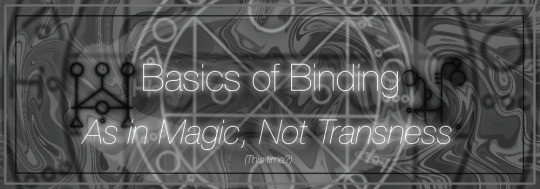
Suggested Reading
Basics of Banishing
Basic Warding
Fundamentals of Energy Work
The Energetic Senses
The Path of Least Resistance
What is Witchcraft? (A massive article that has everything a babe of a witch could want to know)
What is Binding?
Binding is an action that extends well beyond spirit work. Binding is the act of connecting two or more objects, spirits, people, or concepts energetically with spellwork. This spell is typically one that creates a limitation of some kind. This, however, isn't always the case. When a spell connects two things, it is technically a binding. The most common types of binding are ones that bind spirits to objects, or bind people from certain behaviors. A lot of naive practitioners perform bindings as “love” spells, when all binding spells often lack consent on at least one side of it.
Blood magic is also binding magic. It binds the working to the practitioner who supplied the blood. It is a relatively common misconception that blood amplifies spellwork. Anything that creates a connection is a binding.
Why is Binding Important?
Like banishing, it is a necessary skill that every witch should know how to do. Binding is used far more often than one might realize. If performing a spell that includes a bind without knowing it is a binding, you may incidentally cause your spell to be less effective or completely ineffective. Not knowing how to bind intentionally, or what method of binding is best suitable for the casting, causes the practitioner to have less control over their own working. In some cases a practitioner may find themselves on the receiving side of a binding. Without knowing how to bind, breaking that binding becomes increasingly more difficult.
When is Binding Important?
While it may never need to be used, depending on the craft, knowing when to bind is so important. In some cases binding may be used when banishing would be more appropriate. Binding really should only be employed when it is desired for a connection to be made, while knowing what potential side-effects may arise from it. Binding an entity doesn’t trap it inside the object, it traps it into that object’s localized field. Wanting to use magic to get a job could be accomplished by a binding; however, if that job is acquired, then the binding will still be intact. In cases like this, it is optimal to program a backdoor into a spell. Here is a list of some circumstances in which binding would be very useful:
Capturing a spirit
Preventing someone from using specific language
Preventing someone from certain behaviors
Keeping two people in the same mental or physical space
Keeping someone from thinking certain types of thoughts
Attaching a spell to a person, typically through a taglock
Causing two+ people, spirits, or objects to cross paths
Causing a specific event to occur
Causing someone to change their philosophy
Types of Binding
Spell Binding: Binding a spell to a person, place, or thing.
Spirit Binding: Binding a spirit to a person, placee, or thing.
Fate Binding: Using Fate Strings to connect two things in time.
Action Binding: Binding to cause or prevent specific actions.
Thought Binding: Binding to cause or prevent specific thoughts.
Conceptual Binding: Binding to modify conceptual understanding.
How to Perform a Binding
Decide on the target(s)
Gather anything that helps you build your headspace, passion, and intent such as: herbs, music, crystals, feathers, twine, rope, candles, etc.
Gather anything that is representational of the thing(s) you are binding. Ex. Taglocks, books, quotes, sigils, etc
Perform your casting
Connect the spell energetically to the representation(s) and/or objects(s).
Ensure that the energetic connection lies between all desired targets.
Close the spell.
How to break a binding
The most common situations in which a witch would need to break a binding are to dismantle a failed or undesired spell, or to remove a casting someone has placed onto them. Regardless of why, to break a binding is dependent on the type of binding it is. Fate binding is by far the most difficult to break if it is cast intentionally, nigh impossible. Other types of binding only require three things: a receptacle, a decent understanding of energy work, and similar representations as the original spell. If the spell originated from you, then use the same representations you used to cast.
Locate where and how the binding is attached. This can be done using energetic senses or psychic abilities.
Prepare headspace and gather representations and the receptacle.
Pull on the energetic connection to isolate it in space, while anchoring it to the receptacle instead of its original target.
While energetically sustaining the connection, sever the cord. In order to do this, I imagine my hand to be a pair of scissors in order to assist in headspace, while creating an energetically sharp construct around them.
If it helps to project the connection into a tangible cord to physically help, then do so. So long as the energy work is present and it isn’t solely representational or visualization it’ll work.

See my pinned post if you’d like to learn about me, view my services, find other informational articles, view my sigils, or support me on other platforms such as Instagram, TikTok, or Patreon!
#informational post#witchcraft basics#baby witch#witchcraft101#beginner witch#witchcraft for beginners#witchcraftguide#Gspell
199 notes
·
View notes
Text


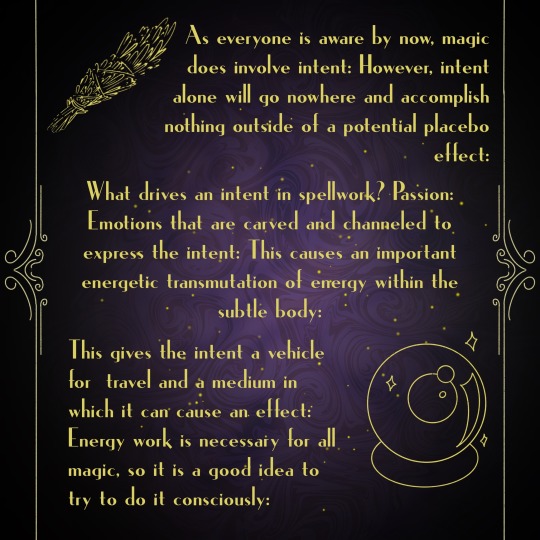
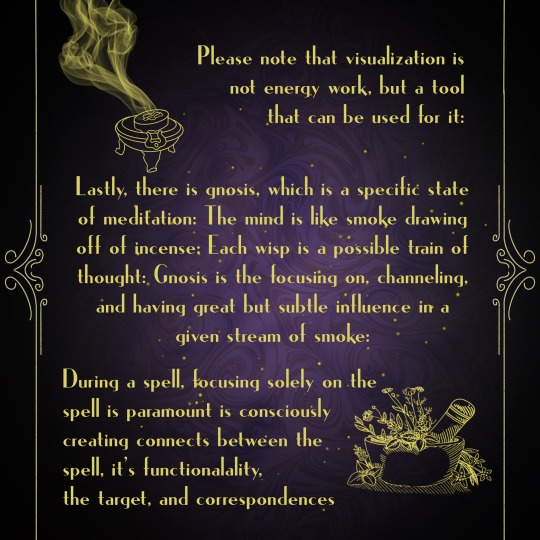

Related Articles:
What is Witchcraft?
Conceptualization Vs. Visualization
Witchcraft Research Tips
Energy Work Fundamentals
Basics of Spell Casting
#informational post#image#witchyvibes#witch aesthetic#spellwork#spellcraft#witchcraft resources#baby witch tips#baby witch#witchy art#Gspell
136 notes
·
View notes
Text
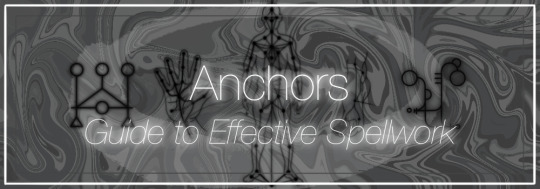
Suggested reading
Energy Work Basics
Conceptualization vs. Visualization
Energetic Awareness
Energetic Constructs
The Subtle Body
The Wellsource
What is an anchor?
An anchor is an object that a spell (see construct) is housed within and sustained by. There are several ways an object can be anchored; short term, in spells that involve burning or destroying the anchor during or after the working to release a wave of energy (projection); moderate duration, in which spells have a decided end and is programmed to diffuse or be released; and long term, most optimally used for wards, these projections are anchored into something that sustains the construct for as long as possible.
Why is anchoring important?
All magic involves a projection or transference of energy, even if subconsciously. When energy is moving it is important to be able to sustain it and keep it from diffusing into the environment and/or to sustain its properties in lieu of ambient energies. Even if the timeframe of the working is very short, energetic half-lives can be significantly shorter depending on the composition. During any working, even with divinity, it is wise to use an anchor as an intermediary for the working so that nothing is altered or lost in transference. A good example of anchors that aren’t widely done consciously are divination tools. When a practitioner uses a pendulum, it is common for it to be cleansed and then programmed. Since the working is on the pendulum itself, it becomes an anchor. The same goes for tarot and most other forms of divination. These anchors are charged and maintained while they are being used.
How to anchor effectively
When choosing an anchor for a spell it is important to take the timeframe of the working into account. Paper, wood and other destroyable non-conductive materials are great for short term spells. These anchors can be destroyed to release the construct to do what it was designed to do before quickly dissipating. Sigilwork can be a great example of this. Iron and copper make for great anchors for keeping the construct from interacting with environmental properties, but do not do well with sustaining it energetically, because of this they are best when housing spiritual entities. Piezoelectric materials make the best anchors for long term spells. Even under atmospheric pressure, they release the most minute energy; which, is more than enough to sustain a construct. Quartz is among the best anchors that can be used, which is why it is commonly thought of as being useful in any working.
Some anchors can also be used to filter energies or modify their properties. Glass, gold, and silver are good examples of this. They each take energies that they hold or absorb and their inherent energies react with them. Glass, however, is the easier to program.
To learn more about me as a content creator, commission sigils, commission a script, get a divination reading, or see a list of all my witchcraft related articles, click here!
#energy work#spellwork#spell casting#warding#protection magic#informational post#witchcraft resources#witchcraft basics#witchcraft for beginners#beginner witch#Gspell
199 notes
·
View notes
Text

Suggested Reading
Introduction to Gnosis
Conceptualization Vs. Visualization
Basics of Binding
Basics of Banishing
Introduction
Gnosis, being the combination of headspace and focus, is an altered state in which the mind and self are indistinguishable from the task at hand. Though it may not seem like it, gnosis is especially helpful for those with attention disorders. However, it may be more difficult to enter into it than for others. Gnosis is very similar to experiencing hyperfocus.
Phases of Gnosis
To begin entering a state of gnosis, the subject and/or goal of the gnosis has to be decided on and thoroughly conceptualized. Gravity can be a very helpful analogy here. The headspace is like space and the point of desired gnosis is a planetary body. Focus is the orbital path that eventually merges with the center point and becomes a part of the mass. When first starting, The more understood and internalized a concept you have for your gnosis is, the larger the mass of the planetary body. The more time and space you lay out for your headspace and the purer it remains through the process, the smoother the orbital will be.
When first starting to enter gnosis, the orbital might be long and spiraling gradually ebbing towards the point in which gnosis is achieved. As you get more acquainted with the process, the orbit (focus) will gradually become shorter and require less time and energy before it drops into place.
If all conditions and preparations are in place, the first phase of entering gnosis is similar to a meditation. When first starting it may be helpful to sit in a comfortable position. A feeling like you’re drifting is normal, but remain tethered to the core concept. Once you start to drift, begin honing your focus on the core concept and how it relates to whatever working you are doing. Try to build as many connections as you can. This part of the process may feel fragmented or chaotic. Once all connections are established, try encompassing them all into a singular concept within your mind. This should feel like a stream of water that becomes more fine as the force of it grows stronger.
Lastly, move into the concept. Be of one mind about the concept. This should feel like a complete stillness, that somehow has some sort of rotation about it. Everything falls into place very quickly. It will be sort of like having tunnel vision. Once in gnosis, you can begin your working.
Types of Gnosis
The types of gnosis vary in terms of how they are experienced as well as their optimal applications.
Conceptual gnosis: This type of gnosis focuses solely on the non-physical. Things like love, morals, energy work, prosperity, etc. This type of gnosis is best applied to wide-cast magic, energy work, and spells relating to emotions.
Physical gnosis: This type of gnosis focuses solely on physical experiences. Things like exercise, sexual pleasure, physical senses, etc. This type of gnosis is best applied to spells that effect the body, exercise, sex magic, and enhancing physical senses.
State of grace: This type of gnosis is the most difficult to enter into. It focuses on all aspects of being, it is similar to the idea of experiencing “the highest self” or whatever those new age crystal-fascists call it. In this state of gnosis, your identity amalgamates into a singular presence, physical, psychic, and energetic senses become extremely heightened. Intent becomes what you are. All spellwork becomes much more potent. Substances are often used to try to get into this state. This type of gnosis will be the sole focus of the next article.
The Potency of Gnosis
Gnosis, once entered into, can vary in its potency. The type of gnosis can also affect the potency of the experience. Conceptual gnosis can probably vary the most, as some concepts are more aggregate than others. The more a practitioner can streamline their concepts into a singular form, the more potent it will be. Studying the concept at hand and having all of the available scientific, philosophical, and nuanced information adds significantly to the gnosis. This can be furthered by incorporating your specific circumstances around the concept. As an example, if someone is getting ready for casting a prosperity spell, they could research the different types of wealth, the way money moves through the system, the monetization of labor, community structures and connections. Then figure out how it connects to their life. By incorporating how people they know, their job, their art, etc works within those systems. Then collapsing all of that information into a singular concept. The more information that is incorporated the more potent the gnosis will be and feel.
Engaging in Witchcraft While in a State of Gnosis
It is so important to prepare before entering gnosis for spellwork! Be sure to set aside space and time for this, put on music that helps you create your headspace, and put on something comfortable. Also, if there are any incantations, gestures, energy work, and/or ritual components it is important to try to have all of those aspects memorized and incorporated into your gnosis. This is so that performing these actions won't interfere with the gnosis. Gnosis shouldn’t be broken until the end of a working. If gnosis is broken before the end of the spell, it is best to bind and banish the spell and restart. Once solidly in gnosis and free of distraction, begin the spell. During the working, it should feel like the combination of a trance and out of body experience, one that is solidly rooted in the body if that makes any sense.
Safety Notes
Some forms of gnosis can exacerbate some mental illnesses. It is important to remain self aware and practice safely. Some really potent forms of gnosis can also be difficult to get out of completely. I highly recommend grounding thoroughly afterwards without entering into gnosis and doing something that is a little shocking to the body, like a splash of cold water to the face. Having gnosis linger can affect how you interact with your daily life, even if you do not have a mental illness.
Enjoy my work? Consider supporting me on Patreon!
Here you’ll find info about me, my service, and a link to my masterpost!
80 notes
·
View notes
Text
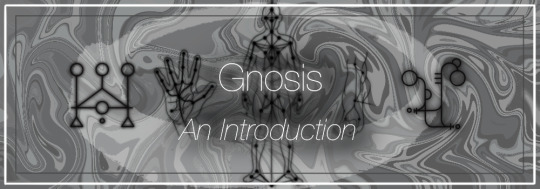
What is Gnosis?
Gnosis is a feminine Greek noun which means "knowledge" or "awareness." In a magical context it is the act of creating an iron curtain around a headspace or focus on a singular action, event, goal, concept, or interaction. This practice is used to increase the potency and accuracy of magical action. Gnosis is a type of meditative state in which the practitioner gains complete awareness of a singular thing and everything else fades away completely. This practice can be very difficult for some neurodivergent people or those who suffer from some mental illnesses; but, it is possible given practice and patience.
This post is an introduction to the concept, not so much as a guide.
Differences Between Gnosis and HGA
HGA or “Higher Guardian Angel” is the practice of connecting with an entity that is thought of as being a silent follower, a being of knowledge and protection. This being is considered to be a higher version of the self. This belief was created by The Golden Dawn, a hyper-misogynistic and subtly fascist occult group. It was then further modified by Alister Crowley, who was also hyper-misogynistic and homophobic. This practice was appropriated from several abrahamic traditions and beliefs from the renaissance era. Whereas gnosis was an action that is dependent on the self and the conscious and subconscious mind and was a term used by several practices to mean awareness and understanding- typically in a spiritual sense. There exist several rituals for entering gnosis, like HGA, but they aren’t at all necessary.
Mundane Applications of Gnosis
Gnosis can be used for a variety of applications. From powering through menial tasks to accomplishing things that ate very difficult. One can enter a state of gnosis on working our at the gym, doing the dishes, hygiene, and house cleaning. Beyond these, it is possible to enter a state of gnosis on activities that are enjoyable, like writing, painting, and playing music. IT is possible to enter a state of gnosis in order to learn. Doing so makes conceptualization a lot easier. Using gnosis as often as you can, will allow you to become more familiar with entering and exiting the state.
You can read further on conceptualization here.
Magical Applications of Gnosis
Gnosis, at its core, is just focus. Headspace. The main difference is that it is an unbreakable focus, at least externally. Once deep into gnosis, the only person who can extract the practitioner is themselves. The reason for this, is that gnosis is giving a physical sense and related neural pathways so much of their awareness that everything else becomes more like a background process. Unrelated external stimuli are noticed, but they may not be directly processed until the practitioner decides to. Once a practitioner has achieved this state, within the confines of their goal, they are granted unrealized access to the extent that their magic can function. Gnosis makes energy work so much easier, regardless of its complexity. It also makes spirit and deity communication significantly easier.
If you'd like to read more about me, see my other content, request content, commission a sigil or divination reading, click here.
153 notes
·
View notes
Text
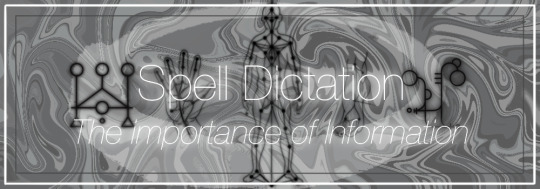
Spell Dictation: Forward
This post is aimed at three target audiences. The first are witchcraft content creators, in the hopes that they will start publishing spells that can accurately be reproduced by their followers. The second are advanced witches, in aims to give them an idea as to what direction they can expand their crafts. The last, and most important are the fledgling witches. Let this post act as a warning and as food for thought about your craft. 100% of the spells you find on the internet do not contain enough information to be accurately reproduced.
Word definitions:
Encryption: the process of converting information or data into a code, especially to prevent unauthorized access
Cipher: a secret or disguised way of writing; a code.
Subtle Body: The energetic system that is constructed of energetic fields, nodes, and conduits that connect them.
Energetic Awareness: The ability to be aware of energetic density, volume, properties, movement, and location.
Energy Point: An energetic node within the Subtle Body
Energetic Gates: An artificial Energy Point that connects a practitioner to a specific source of energy.
Conlang: AKA Constructed language, is a language that is created by one or a few individuals. Sometimes referred to as a fictional language.
Script: A set of symbols used to represent words, concepts, and/or sounds.
Orthography: The graphical representation of sounds, The Latin alphabet is a good example.
Transcription: The act of creating a new script that has a 1:1 representation of each letter in a language’s orthography.
Headspace: The ideal environment and mental state that allows for complete focus on a single task.
What is Spell Dictation?
Spell dictation is how a practitioner describes their spells on paper, digitally, or online. It can range from writing a spell out to having nothing but encrypted graphic representations. This process seems more difficult than it actually is when just starting. In essence, all it really takes is the time to sit and think about what you want to do and how you want to do it. Throughout most of classical magic’s history it was very common to encrypt magical writing. John Dee immediately comes to mind, as he was also the official cryptographer of the queen. As such, all of his occult workings and illustrations were heavily encrypted. Which worked successfully, as many practitioners use his works as they appear, rather than decrypt them. I have made an in depth post about the process of designing a spell here.
Why is Spell Dictation Important?
Being in the proper headspace is so important when casting. For a lot of people, the aesthetics of their spell is just as important for maintaining headspace as music and lighting. Without being in a good headspace the likelihood of your spells working as intended drops significantly. And having a spell that takes up several pages will cause you to break from it and ruin your headspace. If you mark all your pages with significant information, references, symbols, and incantations, then you can check all your sources before casting in order to have a seamless spell process. If you feel that you'll be able to remember every detail about the spells you put into your books, and you don't plant on sharing any online- then just use this post as a guideline for spells you find on the internet.
Necessary Elements of Spell Dictation for Accurate Spell Replication.
In order for your spells to be accurately reproduced by another practitioner it is important to include enough information. There are a lot of variables when it comes to casting a spell and sadly there's almost no modern spell dictations that contain enough information. The important variables to record are:
Subtle body programing/orientation
All possible nodes. (If a memory is a node, it will not translate perfectly for another practitioner.)
Physical objects used and the process of using them
The energetic process throughout the entire spell
The required state of awareness
The variables for building headspace
The center or source of passion
The intent and focus, depicted exactly as it was cast the first time.
Prominent energy points
Energetic current flow and density as it moves through the subtle body and the paths that it takes.
Time and locations, if necessary or desired.
What it targets
How it targets and/or reaches that target
Any spirits used in the spell and their properties and roles in the casting. Potentially even how to summon or commune with them.
Psychic abilities used and how they were implemented specifically, if necessary
Any incantations, their meaning, and any sigils that were used.
Any gestures or bodily movements that were significant.
Any symbols that were used other than sigils
Thorough descriptions of any energetic constructs and thoughtforms used.
Any astral information if necessary.
Any energetic gates used.
As a neat side-effect of densely representing information, your book of spells will be difficult to read without study. This is okay, as you’ll still be able to read it clearly.
The rest of this post is for inspiration and guidance on how to achieve the necessary amount of information.
Concepts for Spell Dictation
An important aspect of thorough spell dictation is being able to fit as much information as possible onto a single page of your medium of choice. This is done by the application of magical scripts, sympathetic notations (symbols that represent a much longer word or sentence), Sigils, Magical symbols, graphical representations, illustrations, encryption, conlangs, allusions to other texts/books, and general clever design.
Using a Magical Script & Conlang for Spell Dictation
Magical scripts are special orthographies used to either write in a conlang or transcribe your chosen language. These scripts can be built on the phonetic sounds of a language or a 1:1 representation of that language's orthography. Doing so does two things at the same time: makes it difficult for others to read your work, which can be perfect for discreet practitioners; and, adds to or improves the general aesthetics of your work. Which can be extremely beneficial; for generating a headspace once you have familiarized yourself with your own methods. Using a conlang can make your spell feel more magical, especially if you design the language yourself and choose what sounds make up your language.
Allusions to Other Texts or Books
You can create a code to reference outside material that takes up very little space on your page. A simple number sequence can be used to describe the page number and line. Or you can create a code specifically for referencing in another one of your books that is dedicated to relevant information like, charts, tables, correspondences, herbs, gestures, etc. This can be done b y assigning each section in that book a letter, and each entry under that section a number. I do this very often in my second and third grimoires. Doing this allows you to include much more relevant information for casting your spell without taking up tons of space on your page.
Magical Symbols, Sigils, & Sympathetic Notation
One of the most common elements found in spellwork are sigils. These symbols pack a lot of information in a relatively small space. And if they’re designed a certain way, they can easily be reproduced from the pages of your grimoire, graphic, or online reliquary. Magical symbols work in much the same way, however they can also be integrated into your conlang or script. Sympathetic notation is when you use pictographs, code words, photographs, or illustrations as representations for magical concepts. These won't be inherently magic, but rather would signify important concepts that are to be considered when casting.
Graphical Representation & Illustration
Graphical representation refers to charts, graphs, and/or tables for important information. As much of magic exists on a spectrum it can be very simple and useful to create graphical representations for many of these concepts, especially if the magical concepts are wordy. Illustrations can work in much the same way as it often takes more space to describe a shape or design rather than just dedicating a small space to draw it out. This is a relatively common practice in online witchcraft communities, though most of which are superficial.
Possible Augmentation of Media
Sometimes, it can be very helpful to notate spells with the music you like to use to cast. The song can be augmented and written in your grimoire to look like song lyrics, alongside a short code to grab bits of information out of the lyrics. This practice can be very useful to discreet witches. The same can also be done with literature, poetry, videos, and movies by notating a time or page along with a code. Sometimes a single quote from a movie can pack a significant punch for the concept you’re trying to capture. Maybe notate the movie or series title with the range of time in which the desired dialog or scene takes place.
Ciphers, Encryption, & Code Words
Sometimes even transcriptions and references aren't enough to protect your information from being read by those that don't have your permission to read it. To solve this issue, you can create an encryption. This can be as simple or as complicated as you’d like. From using conde words to creating a multi-variable cipher wheel. This way, even your transcription wont make sense. Doing so with a magical script would actually add another layer of protection to your encryption. However, doing so can be difficult to use on the fly. The only way it can used once encrypted is to take the time to decrypt your own spell onto a piece of paper or tablet/phone/computer before the spell can be done. I personally only use encryption for my curses and spells that could be dangerous if used by the wrong people or practitioners who dont have enough experience or context to safely cast.
Clever Design
As far as aesthetics and encryption go, you can get very clever with how your information is depicted. There are infinite options for you to choose from when creating your work. One of the biggest elements I would recommend taking into consideration would be continuity of design. If you don’t know where to start when it comes to the aesthetics or designs for your grimoire, I'd recommend starting by watching and reading media about Concepts in Design.
Examples from my own grimoires
The Grey Grimoire
In my first Grimoire I hadn’t really dove into the importance of in-depth spell dictation. The spells in this Grimoire are difficult to reproduce for this reason. I have to remember a lot of the variables involved when I was creating the spells.
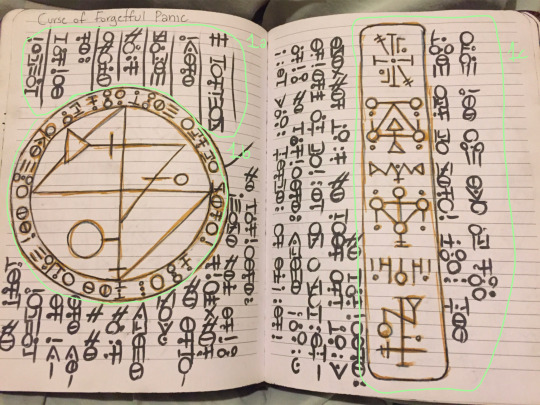
Key:
1a: A list of all the necessary items and tools required for casting.
1b: A spell circle intended to be reproduced for use in the spell and then later burned.
1c: A Sigil-chain and accommodating incantation, intended to be reproduced and burned as part of the spell.
Also, in this Grimoire, I created a complex cipher wheel that is used to decode the Golden Grimoire.
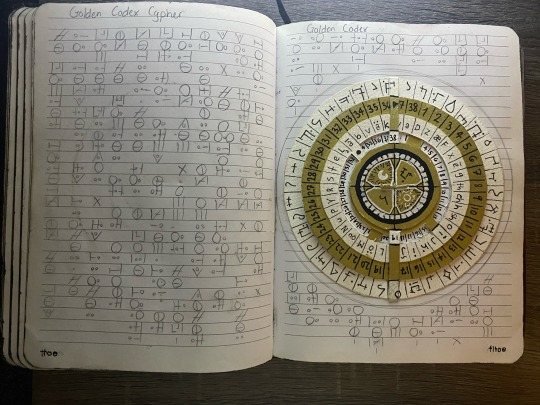
The Golden Grimoire
In my second Grimoire, I started moving away from magic that required physical tools and objects. A majority of the spells in this book are purely gestural and energetic, with a few exceptions. It was here that I began realizing the importance of detailed spell depiction. Unfortunately, I didn’t take into consideration the amount of space all of my reference tables would take up in the book. This Grimoire only has about 12 spells in it as a result.

Key:
2a: A pictographic script used to describe both the gesture and energetic process of casting.
2b: A symbol that denotes the level of difficulty for the energy work involved.
2c: References to tables and infographics within the Grimoire.
2d: A 2D topographical graphical representation of how to program the subtle body and the subsequent energetic fields.
2e: The Sigils involved. In this case they are to be reproduced energetically as constructs.
2f: Symbols that are sympathetic notations of important concepts involved in casting such as: Integral energy points, key energetic properties, and what correspondences are the most important to physical use.
2g: The incantation.
2h: What may look like a spell circle, but in actuality it is a graphical depiction of the gestures and stances over time.
2i: A phrase meant to give insight into the mindset required for casting.
The Red Grimoire
In my third Grimoire, which is still very much a work in progress, I applied a lot of what I learned from the prior two about space management and densely recorded information. In this Grimoire, the spells are 100% gesture and energy based and require no physical objects at all whatsoever. Furthermore, the spells in this Grimoire are designed to be modular so that they can be combined to create spells with more specific effects, as each element within each spell is depicted in it’s entirety in terms of energetic programming, mindset, gestures, etc.

Key:
3a: The title of this specific combination of gesture magic and energy work.
3b: A more detailed 2D topographical graphic representation of the subtle body’s programming.
3c: A more refined variation of the pictographic script used to describe the gestures and energy work.
3d: Important information related to the process of preforming this spell-component.
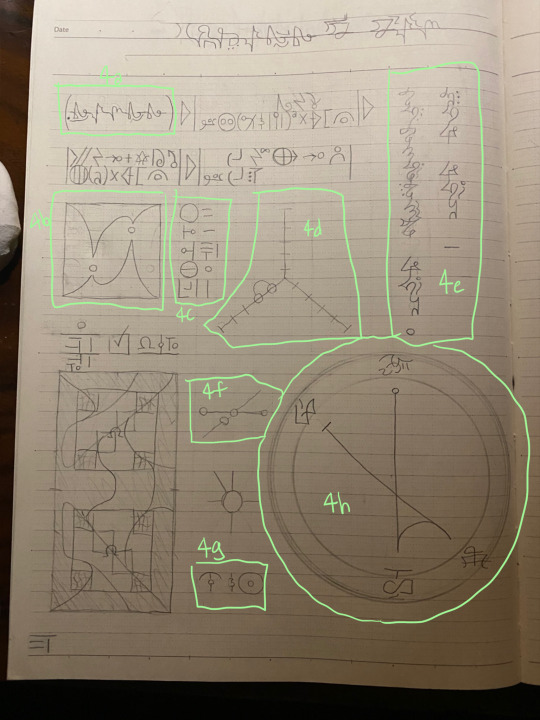
Key:
4a: The beginning of this gesture is notated to begin with the spell-component page above this one.
4b: A graphical representation of the shape of the energetic constructs involved in casting.
4c: References to other books, like the prior two grimoires.
4d: graphical representation of the level and point of focus of Gnosis
4e: Important information required to maintain the proper headspace.
4f: The bodily stance that should be used through the entire series of gestures.
4g: Important Energetic points that should remain in use throughout the entire spell process.
4h: A graphical representation of how the intent and headspace should shift throughout the spell process.
Word definitions:
Encryption: the process of converting information or data into a code, especially to prevent unauthorized access
Cipher: a secret or disguised way of writing; a code.
Subtle Body: The energetic system that is constructed of energetic fields, nodes, and conduits that connect them.
Energetic Awareness: The ability to be aware of energetic density, volume, properties, movement, and location.
Energy Point: An energetic node within the Subtle Body
Energetic Gates: An artificial Energy Point that connects a practitioner to a specific source of energy.
Conlang: AKA Constructed language, is a language that is created by one or a few individuals. Sometimes referred to as a fictional language.
Script: A set of symbols used to represent words, concepts, and/or sounds.
Orthography: The graphical representation of sounds, The Latin alphabet is a good example.
Transcription: The act of creating a new script that has a 1:1 representation of each letter in a language’s orthography.
Headspace: The ideal environment and mental state that allows for complete focus on a single task.
If you have any questions or content suggestions, click here. If you’re brand new to witchcraft, I recommend checking out this post.
#grimoire#baby witch#advanced magic#advanced witchcraft#witchblr#informational post#sigils#image#grey witch#Gspell
213 notes
·
View notes
Text
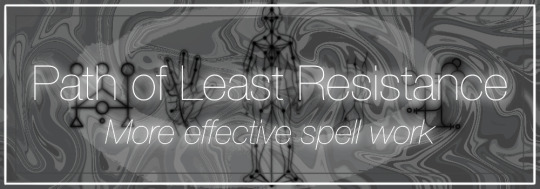
Suggested Reading
What is Witchcraft?
Spell Design
Conceptualization Vs. Visualization
Introduction
When a witch (Or other practitioner of magical and mystical forces) casts a spell, what are the chances that the spell will succeed? It’s a trick question, really. Spells can be, and often are, highly dependent on circumstance. Each minute nuance of the given environment, emotional states, physical interactions, outside events, and outside information all play a role in the probability of a spells success. Think of a spell, for sake of understanding, as a force that has a miniscule effect on the likelihood of an event occurring. This can be getting a job, being noticed, not being noticed, drawing money, manipulating street lights, etc. The possibilities are limitless, so long as the laws of physics are considered. This school of thought can also be called the principle of least effort.
Circumstance
The circumstance that a practitioner finds themselves in at the moment of a working will have a great effect on the success of that working. Does the working consider the emotional states of people involved? The normal movements of people, goods, and objects throughout the day? The more variables that are considered, the more likely the spell will cause a desired effect. Further, the way that the spell is designed to navigate these circumstances will have an even greater effect. An example would be: It'd be better to cast a spell for a resume to stand out among the others than to try and cast a spell onto the hiring manager. This is because the manager has so many nuances to their individuality. They interact with so many people, objects, and events throughout their day and going through resumes is just one of them. While enchanting a resume itself will only call their attention in the moments they set aside to go through them. There are significantly less variables to consider. It would be wise to have the enchantment also have an effect that happens upon viewing it that can help disconnect the manager from the stresses and other preoccupying nuances of their daily life, even if just for a moment.
Abduction, Induction, & Deduction
Deductive reasoning works from the more general to the more specific. Sometimes this is informally called a “top-down” approach. This involves beginning with thinking up a broad idea about our topic of interest. It is then narrowed down into more specific nuances that we can test, observe, or sympathize with. Then, it is narrowed down even further when we collect observations to address the original idea. When using deductive reasoning in witchcraft, it can be as simple as learning more about the environment the spell is going to affect, or as complicated as learning about statistical maths or physics.
Inductive reasoning works the other way, moving from specific observations to broader generalizations and theories. Informally, this is sometimes called a “bottom up” approach. With inductive reasoning, The first step starts with specific observations and measures, and detecting patterns and regularities, formulating some tentative idea that we can explore, and finally ending up developing some general approach. This skill can be handy when designing a spell before actually having a use for it. This approach will also help outline the optimal or beneficial circumstances for the spell's success.
Abductive reasoning works by drawing from known information and making educated guesses to fill in the blanks. This can be extremely useful for spell design, provided you have a lot of information to start with. When enough is learned about a situation, it becomes a lot easier to extrapolate from that incomplete data for a broader perspective. This makes navigating the situation much easier than going in blind. However, unlike the other two a broader bank of knowledge is nearly required.
Statistical Analysis & Probability Calculation
While statistics aren’t at all necessary to cast effective spells, it can certainly be very helpful. Using statistics for applications has to do with studies in psychology and sociology; as well as odds of events, like estimating the amount of resumes that a manager has to go through and calculating the probability of the placement of your resume in the fold. There are two types of statistics: descriptive statistics, which describes the properties of sample and population data, and inferential statistics, which uses those properties to test hypotheses and draw conclusions. Descriptive statistics are the most useful in the application of magic. Inferential can be useful, like in the example that I gave with the resumes. While they may not be necessary, understanding how to calculate probabilities can be a great tool to figure the path of least resistance.
Variations in Energetic Requirements
Both physically, and in an energy work sense trying to force a spell through a more complex path than necessary can be very draining. If the spell is too complex, which sometimes is the best option, could require more physical effort to follow up. Which can be helpful anyways, especially when it comes to subjects like mental illness; which, should always be second or third in terms of treatment. In an energy work sense, if the spell is too complex relative to the working done and/or the energy given, the spell won't be as effective, but could also just not work at all. There is a ratio that exists for energy put in and the complexity of the situation. This ratio can be difficult to figure out when first starting, but with the help of detailed spell logs it is possible.
To learn more about me as a content creator, commission sigils, commission a script, get a divination reading, or see a list of all my witchcraft related articles, click here!
#witchcraft#baby witch tips#begginer witch#witchcraft for beginners#witch tips#witchblr#informational post#witchcraftguide#witchcraft resources#Gspell
121 notes
·
View notes
Text
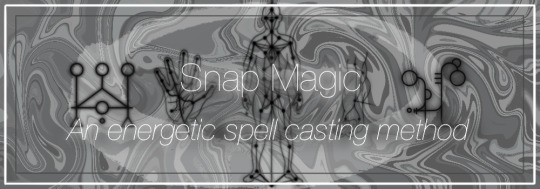
Introduction
This post was originally published years ago on my old blog. I have since updated it.
This is a type of spell casting that I have been using, specifically in public places. This spell casting method is based on sigilcraft and energy work. This means that it is very accessible to every kind of witch. The only necessary physical action a practitioner should be able to do is snap. This is also assuming that the practitioner is at least familiar with the foundations of energy work. If still learning it can be helpful to reinforce the practice with bodily movements. For the sake of clarity for newer practitioners, I’ll be describing the process through bodily movements. Since this type of spell casting involves sigils, the most difficult part is remembering the sigils well enough to recreate. If you create your own sigils, you can create them on a whim using intuition, but I’d only recommend that only those well-practiced in sigil craft do so.
If you are unfamiliar as to what a sigil is, I have made this post. To see how I make my sigils, I have made this post.
If you aren’t familiar with energy work, or are under the belief that visualization is energy work, I highly recommend that you check out this post that I wrote. As well as this post on the fundamentals of energy work.
While using this method, it is important to understand that visualization is only useful for a single aspect: planning. It can be very helpful to visualize what your sigil will look like in space before energetically constructing it.
The Method
Step #1:
Using your dominant hand, draw a circle about the size of your torso. (Once you become well acquainted with energy work, the amount of actual body movement can become extremely minimal, if not non-existent.) Then hold up your non-dominant hand, open palm forward, at your waist/hip and begin visualizing that the circle is maintained and can be moved around by your non-dominant hand.
Step #2:
Draw energy from your wellsource and program it. Then, using your dominant hand again, draw a sigil within this circle, while using your non-dominant hand to maintain it. The half-life of the energies involved are very short and they will dissipate very quickly if not maintained.
If you aren’t familiar with the wellsource, Id recommend reading through this post.
Here is an example of a sigil that I regularly use, as I would visualize it before construction:

This sigil is used to break and dispel curses.
Step #3:
Once your sigil is complete, begin feeding it the energy and intent necessary to power it through your dominant hand, while adding a spin or movement to the sigil with your non-dominant. Once the motion is strong, and the sigil is adequately charged, walk through the sigil. Maintain the sigil with your controlling hand until it has fully intersected your body. Then snap with your dominant hand. You can also use a word of power or incantation at this point as well. Say the magic word. For me, when breaking curses, I may use the word “Break”. Make it short, sweet, sharp and powerful; even if it is done mentally.
Once this kind of casting becomes second nature, you can begin to do more complicated spells. Like casting a spell that has three sigil circles, that all float around your body at different angles; casting energetic sigils that exist in the same point is space, but are separated by spatial dimension, or out of phase with each other; or casting entire spell circles.
It was a pain to find, but here is the original post!
88 notes
·
View notes
Text

Using fate strings in magic:
In order to use fate strings in magic you have to be able to obtain them. The way I obtain them is by astral projecting a single arm (typically my dominant one) which is then used to reach into the throat of my subtle body and down near my well-source. All strings of fate connected to your person will be attached to your well-source. Upon grabbing the strings you don’t want to pull with a lot of force, but rather gently and slowly so that you don’t damage them in anyway. Once they are outside of you and you have all of them in your hands you can either use all of them for working or you can find the specific one that you’re after; or even a specific set. Whenever I go to cast using fate strings, I have two methods; one method destroys the fate string, entirely consuming it after the spell has been cast. The way this works is to knot the energy within that string and then fill the string with energy so that it pushes that knot down the conduit. Then, after the spell has been sent down the conduit, cut it and that causes the string to consume itself in order to correct the knot.
The other method involves casting a spell like normal, except instead of sending it through a tag lock or through a portal or through anything of that nature or even rather aimlessly into the sky, I use the feet string as the conduit for the spell to travel down the only reason I would use the first method is if I do not want the spell to be returned the second method though is the most common usage for me.
If you have any questions, click here.
48 notes
·
View notes